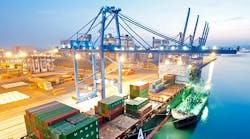China’s export trade growth accelerated in September, signaling that producers expedited sales abroad to avoid fresh tariffs imposed by the Trump administration.
Economists said the surge, which contributed to a new record trade surplus with the U.S., can’t last.
Exports in dollar terms rose 14.5% in September compared to the same period last year, the customs administration said on Oct. 12, defying expectations for a slowdown to 8.2%.
Imports climbed 14.3%, leaving a trade surplus of $32 billion.
China’s exports have been growing robustly all year, in the face of the worsening standoff with Washington. Companies rushing shipments to get in ahead of extra tariffs of 10% on another $200 billion of sales to the U.S. will explain some of the rise, and that incentive has strengthened now that President Donald Trump has ordered the rate to increase to 25% starting next year.
China Races to Get Toys and Car Parts to U.S. Before Tariffs Hit
"I think this was still subject to the front-loading effect ahead of the implementation of the $200 billion of tariffs," said Betty Wang, a senior economist at Australia and New Zealand Banking Group Ltd in Hong Kong.
In contrast, a gauge of new export orders based on a survey of manufacturing purchasing managers that the government published earlier this month fell to its lowest level in two years. That indicator tends to lead the official data on exports, and "might indicate some slowdown in the coming months," Wang said.
U.S-China Trade
Growth in exports to the U.S. accelerated to 14 percent from a year earlier in U.S. dollar terms, up from August’s 13.2 percent rate. Imports from the U.S. contracted 1.2 percent, the first decline since February.
Beijing and Washington imposed more tariffs on each other last month, with no sign that either side will back down and tension spreading to other areas. While Trump has pressured U.S. Treasury Secretary Steven Mnuchin to label China a currency manipulator, the U.S. Treasury Department’s staff have advised him that China isn’t manipulating the yuan ahead of the publication of a closely-watched report on foreign currencies, according to two people familiar with the matter.
What Our Economists Say...
Trade headwinds are substantial, and could strengthen in the months ahead, imposing a drag on growth. An end to the trade war with the U.S. seems remote, with the U.S. continuing to ratchet up the rhetoric after imposing fresh tariffs on Chinese imports, and China unwilling to engage in talks at gunpoint.The surprise rise in shipments of products heavily target by the tariffs -- electric motors, mechanical and electrical products -- suggest that companies are rushing existing orders out the door before the full force of the tariffs hit, they wrote.-- Chang Shu, Qian Wan, Justin Jimenez, Bloomberg Economics
Trade growth may slow in the fourth quarter, the customs administration’s spokesperson said at a press conference, while cuts to import tariffs are boosting inbound shipments.
Other gauges of economic activity have been pointing to a continued slowdown. Policy makers have been rolling out measures to support the domestic economy, including looser monetary policy and more fiscal stimulus.
"We estimate that the impact of higher U.S. tariffs on a total of $250 billion of Chinese imports will subtract about 0.6 percentage points from China’s GDP growth, assuming all else is equal," Standard Chartered Plc economists wrote in a recent note




